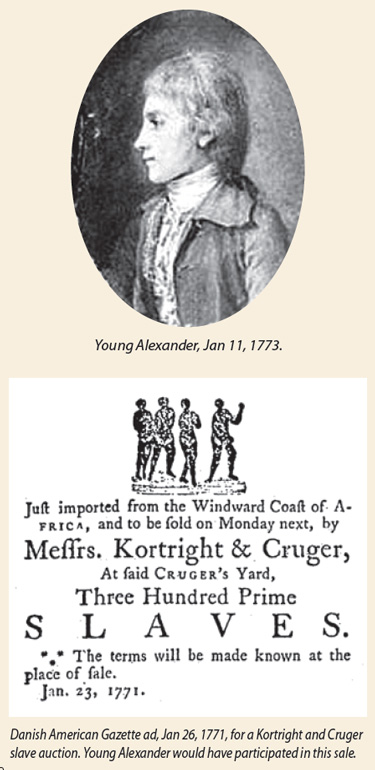
by Meredith Hardy
Every story has a beginning, and most of them begin with a mother. Rachel Faucett Lavien. We know she was born on Nevis in 1729. Her father was a French Huguenot planter and physician. She arrived on St. Croix with her mother, Mary Uppingham, in 1745, to visit her sister and brother-in-law who lived at Number 9 Company Quarter. Within a year young Rachel, merely 16 years old, was married to Johan Michael Lavien and a year later she gave birth to a son, Peter. Within five years, however, the marriage was over. Lavien had his young wife incarcerated in Fort Christiansvaern, accusing her of refusing to live with him as a wedded wife. This attempt to penalize and control his young wife’s actions backfired; once released, Rachel and her mother left the island for St. Kitts.
 Rachel then met James Hamilton, who worked for the company Archibald Ingram, at Basseterre, St. Kitts. Together they lived on Nevis for nearly 15 years, and had two boys: James (1753), and Alexander (1755).
Rachel then met James Hamilton, who worked for the company Archibald Ingram, at Basseterre, St. Kitts. Together they lived on Nevis for nearly 15 years, and had two boys: James (1753), and Alexander (1755).
Back on St. Croix, Lavien filed for divorce in 1759. She was found guilty, forbidden to remarry, and not allowed to make any future claims against her former husband.
In May 1765, the Hamiltons traveled to St. Croix for business. When they stepped off the boat in Christiansted they entered a small, bustling, cosmopolitan port town that was only 30 years old. You could hear many different languages being spoken at any time. There were two main markets, the Daily Market and the Sunday Market, and hucksters would have been walking the streets selling their goods. Over 1,000 vessels entered and left the harbor and port a year. Underlying all of this business and agriculture was the commodity of human lives and labor. And, all of these transactions were conducted without a banking system.
When James’ work was completed in January 1766, he returned to Nevis, alone. Perhaps, as an older Alexander recounted (in Freeman 2001:880) “…my father’s affairs at a very early day went to wreck….This occasioned a separation between him and me when I was very young”.
Rachel opened a small store and sold plantation supplies, while the family lived upstairs. Initially located at No. 34 Company Street, the store was moved briefly to No. 23 in 1767 before returning to No. 34. At age 11, young Alexander started to work at the firm Beekman and Cruger. He was brilliantly smart, and was left to manage the shop while Cruger was away in New York, an experience that would serve him well later in life.
On February 10, 1768, both Alexander and Rachel became very sick, probably with yellow fever. Alexander recovered but his mother did not, and she died nine days later. The next day she was buried in the Lytton family cemetery. The boys went to live with their cousin, Peter, until his death by his own hand in 1769. Young Alexander then went to stay with Thomas Stevens, and his dear friend Ned.
August 31, 1772 was a day that would change young Alexander’s life forever. On that day a powerful hurricane hit the island, and Alexander captured its power and fury in a letter he penned to his father, now living on Tobago. This letter was good enough to motivate people to help get him to North America and a formal education. The rest, as they say, is history.
Years later, as the First Secretary of Treasury, Alexander Hamilton rallied for a diversified economy, the establishment of a small national debt to create good credit, and the charging of modest taxes to pay down the debt. History has aligned him with a strong, centralized government, but his philosophies regarding economy and governance are actually founded on the notion of flexibility and compromise. He believed in the separation of powers and protection of the judiciary from manipulation. While his rise from poverty to national political greatness is known and admired, perhaps he should also serve as a model for political tolerance.
Meredith Hardy is the acting Cultural Resource Program Manager for Christiansted National Historic Site, and is an archeologist and the Coordinator for Interpretation and Education at the National Park Service’s Southeast Archeological Center.
Sources:
Brookhiser, Richard. 1999. Alexander Hamilton: American. The Free Press/Simon and Schuster, Inc.
Chernow, Ron. 2004. Alexander Hamilton, New York: The Penguin Press.
Cissel, William J. 2004. Alexander Hamilton: the West Indian Founding Father. Presented at the
Symposium “Alexander Hamilton, the Formative Years,” Government House, Christiansted, St. Croix. On file, Christiansted National Historic Site, Christiansted, St. Croix.
Cissel, William J. 2007. Alexander Hamilton: Myth, Legend, and Reality. On file, Christiansted
National Historic Site, Christiansted, St. Croix.
Freeman, Joanne B. 2001. Alexander Hamilton. Writings. Literary Classics of the United States, Inc., New York.
Holsoe, Svend. 2014. Hamilton’s Christiansted, National Park Service Report. On file, Christiansted National Historic Site, Christiansted, St. Croix.
Ramsing, H. U. 1939. “Alexander Hamilton og hans Mødrene Slægt. Tidsbilleder fra Dansk
Vestindiens Barndom,” Personalhistorisk Tidsscrift (København), 10 rk., 6 bd, 225-270.
Royal Danish American Gazette, publisher Daniel Thibou (Christiansted, Danish West Indies), 1770-1773.
